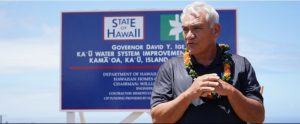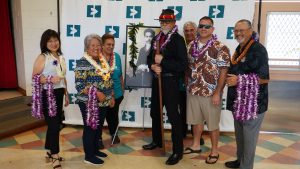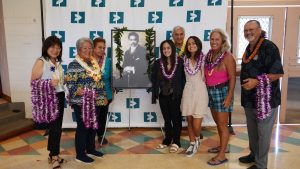DHHL: Moving from waitlists to a place to call home
Posted on May 31, 2022 in Capitol Connection, Featured, MainWhen is a homestead more than just land? If you’re a beneficiary of the Hawaiian Homes Commission Act who has been waiting decades for a homestead, it’s everything. It’s the future of an ‘ohana. It’s promises dating back to Prince Kūhiō and statehood. It’s a measure of respect for your culture and people. And, if you’ve ever been in the room when it happens — as Department of Hawaiian Home Lands Director William J. Ailā, Jr. and Governor David Ige have been — beneficiaries receiving their lot award is a moment to remember.
As House Bill 2511 awaits the Governor’s approval, DHHL is preparing for the record $600 million appropriation that will enable the Department to develop roughly 2,900 homestead lots in the state’s four counties and provide down payment and rental assistance for another 1,100 beneficiaries for properties off of preexisting homestead lands. “When I meet people in the community, it’s a heavy burden when they ask, ‘how soon?’ and the truthful answer is as soon as we get the resources,” said Director Ailā who outlined personal struggles he’s faced as head of the agency. “With this legislation, we’re going to make that dream come true sooner rather than later for thousands of families, and that will be a huge push forward for the implementation of the act.”
The Governor’s recent suggestion that a percentage of the Tourist Accommodation Tax should come to the Department as a consistent revenue stream was an encouraging proposition for the sustainability of progress at DHHL. “I think this proposal is a testament to his understanding of the Hawaiian Homes Commission’s mission and the relationship between the state and native Hawaiians,” said Ailā. “It acknowledges the need for consistent and long-term funding to move the needle in a meaningful way.”
Director Ailā says he does not doubt that Governor Ige understands the impact of receiving a lot — both on an official and individual level. “He’s been with us and seen people jump up and down, screaming and crying, at these offer ceremonies,” the department director and chairman of the Hawaiian Homes Commission noted. “It’s not just the individual at that moment; it’s generational.” During the Ige administration, even with increased levels of funding support for DHHL, the department was challenged in its attempts to reduce the waiting list of some 28,000 applicants. HB 2511 recognizes those hurdles, including the availability of preferred land, cost of infrastructure, and beneficiaries being able to afford mortgage financing. To meet these challenges, DHHL has been deploying new strategies to help more people and will continue to grow its offerings with the $600 million appropriation.
In recent years, the Department has expanded its product offerings in a way that best suits a variety of beneficiaries’ needs and preferences: Turnkey projects for beneficiaries who can afford them; rental housing in urban areas; vacant lots with roads and utility infrastructure to self-build a home suitable to budget and family needs; subsistence agriculture lots; kuleana lots that are larger and less developed; as well as expanded partnerships with the Office of Hawaiian Affairs, nonprofit entities such as Habitat for Humanity, University of Hawai‘i community colleges and other state agencies.
Director Ailā, whose wife is 50 percent native Hawaiian and was awarded land as a beneficiary decades ago, said he feels privileged to be the department’s director at this moment in DHHL history. “I recognize the privilege of being director and of being native Hawaiian as someone who is living on the land. It’s that feeling of connection to ʻāina that I want for all of our beneficiaries,” said Ailā. “I’d like to acknowledge the legislature and the leaders in our community who have supported this bill and recognized the past, present, and future needs of the department. I would also be remiss if I didn’t give credit to our staff at the department, who put in long hours to work towards the fulfillment of Prince Jonah Kūhiō Kalanianaʻole’s vision for this program. We are ready to push forward and ultimately return our native Hawaiian beneficiaries to the land as intended.”


